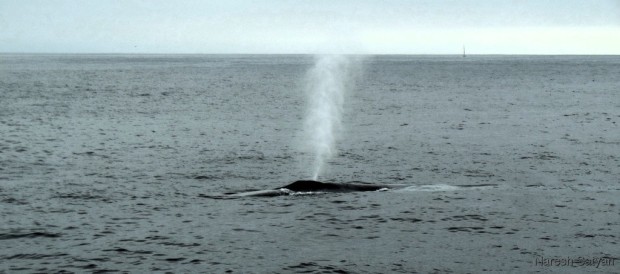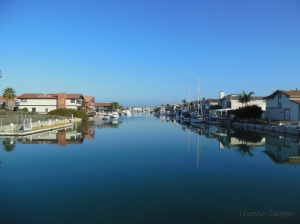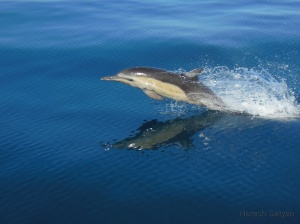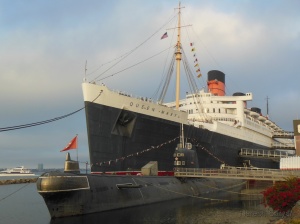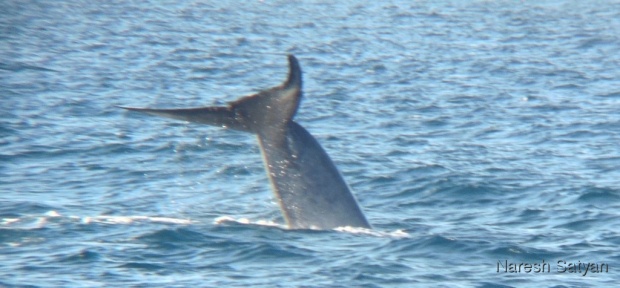The Pacific ocean within a few miles of the California coastline is home to an abundance of life, and this is a sadly under-appreciated fact, even among people who live in Los Angeles. There are several different ecosystems—including the beautiful kelp forests around the Channel Islands that I will talk about at another time—that support an amazing variety of bird, fish, and marine mammal life. This post is about getting on a boat and going out on the ocean to watch the biggest mammals of them all: whales.
A number of different baleen and toothed whales can be found in the California waters at different times of the year. Some species live here year round, such as the various dolphin species (long and short-beaked common dolphins, coastal and offshore bottlenose dolphins, Risso’s dolphins, and Pacific white-sided dolphins). It is not uncommon to go out on a boat, any time of the year, and be surrounded by thousands upon thousands of common dolphins jumping out of the water, vocalizing, and having a good time. They are a delight to watch every time, and there is nothing ordinary about them! Other species visit annually. The Pacific grey whales, once hunted to near extinction, have now rebounded to pre-whaling populations. These animals undertake the longest migrations of any mammals on earth. Every winter (~November to January), they migrate down from their feeding grounds in Alaska to the calm waters of Baja California to give birth to their calves, and migrate back up again a few months later (~February to May). During this time, they stay within a few miles of shore, so it is really easy to watch them, even from shore. In the summer (~June/July to October), the waters are rich in tiny krill, and the majestic blue whales come here in large numbers to feed. Fin whales and minke whales live here year round, humpback whales come down sometimes, and killer whales visit every now and then, sometimes to hunt grey whale calves. This year, there have been several sightings of whales that are very rare for this part of the world, such as Bryde’s whales, false killer whales, pilot whales and sperm whales—very exciting indeed! Other mammals—various sea lions and seals—are commonly seen as well.

A huge Steller sea lion on a buoy outside the Oxnard harbor. He makes the full-grown male California sea lions next to him look tiny!
I only learned about all this wildlife some 3 or 4 years ago when someone mentioned it at a party; and since then, my interest in these animals has grown very quickly. I make it a point to go out on the ocean at least 7-8 times a year, and would do it more often if I could afford it. It is a joy to be out on the ocean even if we don’t see anything (which has only happened to me once). We are lucky to live in a time and place where whales are protected from humans, and various organizations are doing a great job of studying and understanding these whales, and lobbying for their protection by minimizing the use of naval SONARs, changing shipping lanes to protect whale feeding grounds and migratory routes etc. Check out the American Cetacean Society (Los Angeles chapter), and consider supporting them by becoming a member. They have very knowledgeable researchers, organize periodic lectures and whalewatching trips, conduct the annual grey whale census, publish some very interesting journals, and so on. Their Whalewatcher journal alone is worth the price of the membership.
There are several whale watching boats up and down the Southern California coast, from Ventura to San Diego. In some places, whale watching trips only run during the grey whale migration season in the winter; other operators have trips running every day of the year except Christmas. It is easier to find grey whales since they hug the shore (particularly mothers with calves on the northbound journey), so the grey whale trips tend to be shorter and less expensive than the summer trips, with a typically higher chance of seeing a whale. But the summer trips to see the blue whales give you more time on the water, and you can’t beat the experience of being surrounded by blue whale spouts several tens of feet high in all directions! In this post, I’ll list some of the whale watching boats I have been on, and how to get there using public transit. I’ve enjoyed myself on all these boats, and they all respected the whales, so I’ll let you pick a favourite!
Santa Barbara: The Condor Express has whale watching trips year-round, departing from Sea Landing in the Santa Barbara Harbor. Sea Landing is a short half-mile walk from the Santa Barbara Amtrak and Greyhound stations, which are located next to each other. You can also take the waterfront shuttle from the train station, but why? Enjoy the beach :). As of this writing, the first Pacific Surfliner train of the day only gets to Santa Barbara station at 10:19 am, which is too late for the typical 10 am Condor Express trips (it works for the shorter grey whale trips). It is therefore more convenient to take the first Greyhound bus to Santa Barbara, leaving Los Angeles at 6:10 am or North Hollywood at 6:40 am. I prefer the North Hollywood stop, which is a short walk from the Red Line station, is easier to access, and in a much better neighbourhood than the downtown Los Angeles station. The boat gets back to Santa Barbara around 2:30 pm, leaving enough time to look around Santa Barbara and take a train back.
The trips out of Santa Barbara are fantastic for a couple of reasons: there is a much higher chance of seeing humpback whales in the Santa Barbara channel compared to Los Angeles, orcas occasionally visit too, and the boat often makes a trip to one of the Channel islands, weather permitting—so you can see the famous Painted Cave as well! The downside is that like everything in Santa Barbara, it can be a little expensive: $99 in the summer, $50 for coastal grey whale trips.
Ventura and Oxnard: Island Packers, who are the boat concessionaires for the Channel Islands National Park run regular whale watching trips during the grey whale migration season, as well as the summer blue and humpback whale season. Grey whale cruises depart from the Oxnard and Ventura Harbors, are 3 to 3.5 hours long for $36; blue whale cruises depart on specific dates from Ventura Harbor, and are 7 to 8 hours long for $79. All whale watching trips cross the Santa Barbara channel and have great views of the Channel Islands. The blue whale cruises go much further to the west, and may include a stop at the Painted Cave as well. Island Packers also has several landing and non-landing trips to the various Channel Islands, and the crew normally keep a lookout for wildlife during the channel crossings, will spend a good amount of time with any whales or dolphins encountered.
Getting to these harbors is again complicated by the early departure of the whale watching trips, and the first Pacific Surfliner train does not work. The transit option that has worked for me is to take the same Greyhound bus from North Hollywood at 6:40 am that you would take to Santa Barbara, but get off at Oxnard instead. The Oxnard Harbor (confusingly called the Channel Islands Harbor) for grey whale cruises is 5.5 miles from the Oxnard Transportation Center (OTC). Take the Gold Coast Transit Route 5 to Hemlock and Victoria, and walk the remaining 1.7 miles past beautiful homes to the Island Packers dock.
The simplest way to get to the Island Packers location in Ventura Harbor is unfortunately to take a taxi from OTC, an 8 mile ride. This is unsatisfactory, but lets you make it to the harbor well in time for the morning trip. For the return trip or for trips leaving in the afternoon, the Pacific Surfliner is convenient. There is a free trolley service between Ventura Harbor and the Ventura Amtrak station, provided by the Ventura Downtown Harbor Trolley.
San Pedro: Spirit Cruises in the San Pedro Harbor runs whale watching trips during the grey whale season in winter ($25). Trips depart from the interesting Ports O’Call Village, and can be reached using the Metro Lines 450 (Harbor and 1st), 205 (Harbor and 6th) or 246 (Pacific and 7th). Connect with these buses from the Silver Line or other buses at the Harbor Gateway Transit Center. You may also want to ride the cute little Waterfront Rail Car when you are in San Pedro.
Long Beach: On the other side of the twin Ports of Los Angeles and Long Beach is the beautiful Rainbow Harbor in the city of Long Beach. Harbor Breeze Cruises run several whale watching trips daily from the Rainbow Harbor, located next to the Aquarium of the Pacific. I’m a fan of their whale watching boats—great views, stable, and they have a volunteer from the Education department of the aquarium on every trip, who makes the trips educational for beginners. They have two or three trips daily, with their blue whale trips ($45/$50) slightly more expensive than the grey whale trips ($35). Check their website for discount coupons!
Long Beach harbor is the most conveniently accessible among all the options listed in this post, so I end up going on several cruises a year with Harbor Breeze. I have seen grey, blue, fin and minke whales; some cool birds like a pair of masked boobies a few months ago; mola molas, and various types of dolphins on their cruises. Blue whales are my favourite!
Ride the Metro Blue Line all the way to the last stop at the Long Beach Transit Mall, and from here, you can walk the half mile to Rainbow Harbor, or take the free Passport Shuttle operated by Long Beach Transit. Long Beach transit also has cool water taxis across the harbor during the summer months. When you’re in Long Beach, also check out the Aquarium of the Pacific and the Lighthouse at Rainbow Harbor, and ride the free Passport bus to visit dining options at Shoreline village, as well as the magnificient Queen Mary and the Russian Scorpion-class submarine on the other side of the Harbor.
Dana Point: The furthest south I have gone whale watching is Dana Point, in Orange County. Two whale watching outfits operate from Dana Point Harbor: Dana Wharf Whale Watch, and Captain Dave’s Whale Watching Safari. They are a little pricier than the other cruises, given that their trips are typically shorter in duration, but they run several trips a day. Dana Point has a large variety of wildlife within a short boat ride from the harbor.
Transit: there are three options to get to Dana Point from LA, and it helps to have a bike.
- The easy route: Take the Metrolink Orange County Line (or Amtrak, but it is more expensive, and you need those annoying bike reservations) from Union Station to San Juan Capistrano. From the San Juan Capistrano station to Dana Point is a leisurely 4 mile bike ride along the San Juan Creek trail, which should take 15 to 20 minutes. If you are not on a bike, take the OCTA Route 91 to Dana Point (or Route 191 to Capistrano Beach Plaza) from the train station. Or just walk the 3.5 to 4 miles from the station to the beach.
- The scenic route (involves multiple bus transfers, will take quite a long time): The OCTA Route 1 from Long Beach to San Clemente is one of the most stunning bus rides. For $1.25 (until the next price hike), you get to ride on the Pacific Coast Highway for 43 miles, through some very pretty beach towns, and along the Pacific Ocean. Connect to the Route 1 from the Long Beach Transit (LBT) buses at several places in Long Beach—one of my preferred routes is Metro Blue Line to Transit Mall → LBT 121 to PCH and 2nd → OCTA Route 1. You may find a more convenient transfer.
- The scenic and long route on your bike: Sometimes the whale watching trip ends at 7 pm, after the last Route 1 bus to Long Beach or Metrolink to Union Station, and you’re too cheap to take an Amtrak ride. If you’re young and foolish (or just foolish), you can bike along the PCH all the way to Long Beach, heading west and north, and watching the sun set over the Pacific Ocean as you ride. (Actually, while the PCH has wide shoulders without potholes outside the towns along the route, it does not have street lights everywhere, and cars are going at 60 miles an hour in places. I do NOT recommend riding after sunset, but it is a fun flat 50 mile ride during the day.)
There are a couple of cruises I haven’t mentioned in this post and would like to try some time in the near future, particularly down in San Diego, but hopefully this will convince you to go out and get on a boat. You’ll never again want to see a marine mammal in cruel captivity in a depressing tank or performing stunts for humans.
-N
